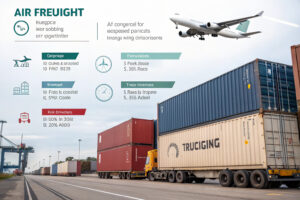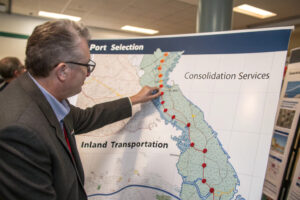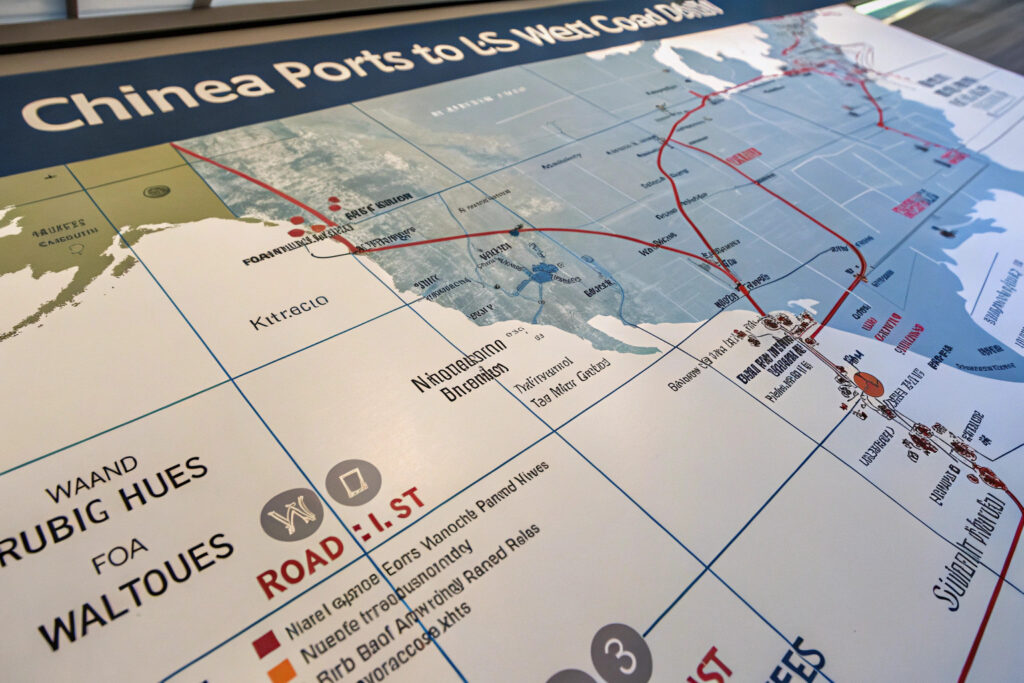Shipping costs can easily erase your profit margins if not strategically managed. With fabric masks being relatively lightweight but potentially bulky, choosing the wrong logistics route can increase your landed costs by 30-50% or more. The most cost-effective solution isn't always the cheapest option—it's the one that balances speed, reliability, and cost for your specific business needs.
The most cost-effective logistics routes from China to US warehouses typically combine sea freight for bulk transportation with regional consolidation for final distribution, utilizing major West Coast ports like Los Angeles/Long Beach for initial receipt followed by inland rail or truck transport to distribution centers. The optimal routing depends on your order volume, timeline requirements, and warehouse locations.
Understanding the trade-offs between different shipping methods and routes helps you select the right balance of cost efficiency and delivery reliability. Let's examine the most practical options for fabric mask importers.
What Sea Freight Options Offer the Best Value?
Sea freight remains the most economical choice for larger shipments, but strategic decisions about containerization and routing significantly impact both costs and transit times.

When does FCL (Full Container Load) become cost-effective?
FCL shipping becomes economically advantageous at approximately 15-20 CBM (cubic meters), which typically represents 30,000-50,000 fabric masks depending on packaging density. The cost per unit advantage of FCL becomes significant at these volumes, with rates typically 40-60% lower than LCL on a per-mask basis. For West Coast destinations, FCL transit times range from 18-24 days from Chinese ports to warehouse receipt, with the most reliable services operating through direct calls rather than transshipment. Our analysis shows that clients shipping 40,000+ masks can achieve per-unit shipping costs of $0.08-$0.12 via FCL versus $0.18-$0.28 via LCL.
How can LCL (Less Than Container Load) optimize smaller shipments?
For orders of 5,000-30,000 masks (approximately 3-15 CBM), LCL consolidation provides the optimal balance of cost and flexibility. Reputable consolidators group multiple shippers' goods in shared containers, with deconsolidation at US ports before final delivery. The key to LCL value lies in selecting consolidators with frequent sailings and efficient US operations to minimize dwell times. Our preferred LCL partners achieve 23-28 day total transit times with demurrage-free operations through established relationships at major West Coast ports.
What Air and Land Alternatives Work for Urgent Shipments?
While sea freight offers the lowest costs, alternative transportation methods provide solutions for time-sensitive situations or special circumstances.

When does air freight make economic sense?
Air freight becomes justifiable when the time value of money exceeds the additional transportation cost—typically for high-margin products, urgent replenishment, or avoiding stockouts during peak seasons. While air costs 4-6 times more than sea freight, the 2-5 day transit time can prevent lost sales worth the premium. For fabric masks, we've found the breakeven point typically occurs when masks retail above $8-10 per unit or when stockouts would damage key retail relationships. Consolidated air freight through hubs like Shanghai or Hong Kong to major US gateways offers the best balance of cost and reliability.
What about rail and truck alternatives?
The China-Europe rail route combined with transatlantic shipping has emerged as a viable middle option for some importers, though it's less practical for US-bound goods. For domestic US distribution, rail transport from West Coast ports to inland hubs like Chicago offers significant cost savings over trucking for non-time-sensitive shipments. Our logistics data shows that rail drayage can reduce inland costs by 30-50% compared to all-truck routes for destinations beyond 500 miles from port, adding 4-7 days to transit times.
How Can Strategic Routing Reduce Total Costs?
The physical route represents only part of the cost equation—strategic decisions about port selection, transit patterns, and consolidation opportunities dramatically impact total logistics expenses.

Why does port selection matter beyond shipping rates?
Choosing the right US arrival port affects not just ocean freight costs but also inland transportation expenses and processing efficiency. While LA/Long Beach offers the most frequent sailings, Pacific Northwest ports like Seattle/Tacoma sometimes provide better total cost for destinations in the Midwest or Northeast due to reduced inland transportation costs and less congestion. Our routing analysis typically compares total door-to-door costs across 3-4 port options, with recent shipments showing 8-15% savings through strategic port selection rather than automatically choosing the most popular options.
How can consolidation services optimize costs?
Regional consolidation services allow multiple smaller shipments to be combined for more economical transportation. Using regional distribution centers near major ports for consolidation before final shipment to your warehouse can reduce costs by 15-25% compared to direct shipping to multiple destinations. This approach works particularly well for businesses supplying multiple retail locations or regional warehouses. Our consolidation program near the Port of Long Beach has helped clients reduce their per-unit logistics costs by 22% on average while maintaining 4-5 day transit times to most western US destinations.
What Hidden Costs Should You Factor Into Calculations?
The quoted shipping rate often represents only 60-70% of total logistics costs, with multiple additional charges significantly impacting your total landed cost.

What are the most frequently overlooked charges?
Port and carrier ancillary fees including terminal handling charges, bunker adjustment factors, peak season surcharges, and currency adjustment factors can increase quoted rates by 15-25%. Additionally, inland transportation accessorial charges like liftgate services, limited access fees, or notification requirements can add unexpected costs, particularly for warehouses without standard loading docks. Our cost analysis for clients includes a detailed breakdown of 23 potential additional charges, with historical data showing which typically apply to their specific situations.
How do timing factors create hidden costs?
The timing of your shipments significantly impacts costs beyond direct transportation expenses. Seasonal rate fluctuations can vary by 30-60% between low and peak seasons, with Chinese New Year, summer peak, and holiday seasons commanding premium rates. Additionally, inventory carrying costs from longer transit times represent real expenses, typically calculating at 20-30% of inventory value annually. Our logistics planning includes seasonal rate forecasting that has helped clients avoid peak pricing through strategic shipment timing, reducing their annual freight costs by 18-27%.
How Can Technology and Partnerships Optimize Routing?
Leveraging technology and strategic partnerships provides visibility and efficiency that individual shippers struggle to achieve independently.

What role does digital freight management play?
Modern digital freight platforms provide real-time rate comparisons, capacity visibility, and automated documentation that streamline the shipping process while identifying cost opportunities. These systems analyze historical performance data to recommend optimal routing based on your specific priorities—whether lowest cost, fastest transit, or highest reliability. Our integrated platform has reduced clients' freight management time by 65% while identifying routing improvements that save 12-18% compared to traditional approaches.
How do manufacturer logistics partnerships help?
Manufacturers with established logistics expertise and partnerships can often secure better rates and routing than individual importers. Our volume across multiple clients provides negotiating leverage with carriers, while our experience with fabric mask classification and customs requirements prevents costly delays. Clients utilizing our integrated manufacturing and logistics service typically achieve 15-20% lower total landed costs compared to managing these functions separately, plus benefit from single-point accountability throughout the process.
Conclusion
The most cost-effective logistics routes from China to US warehouses strategically balance sea freight for bulk transportation with regional consolidation and optimized inland distribution. Success requires considering both direct costs and hidden charges while leveraging technology and partnerships to identify optimal routing based on your specific volume, timeline, and destination requirements. The right solution maximizes cost efficiency without compromising reliability or creating unacceptable delays.
Ready to optimize your fabric mask logistics from China to US warehouses? Contact our Business Director, Elaine, at elaine@fumaoclothing.com to discuss our comprehensive logistics solutions and receive a detailed routing analysis for your specific shipping needs. We'll help you identify the most cost-effective approach that balances your budget and timeline requirements.


























